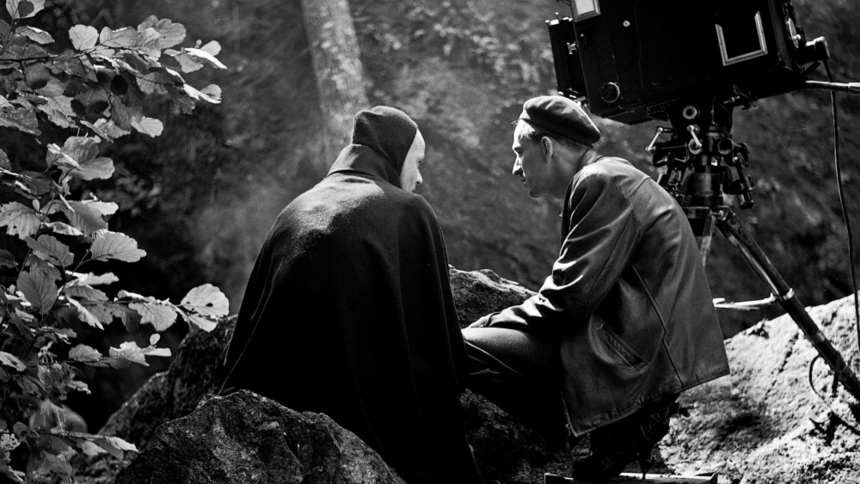Vancouver 2018 Review: BERGMAN: A YEAR IN A LIFE Digs Deep
Jane Magnusson's documentary explores the remarkable year Ingmar Bergman enjoyed in 1957.

I’m writing this review from a friend’s kitchen where I’m staring at a very apropos Jack Kerouac magnet that quotes him saying “All I have to offer anyone is my confusion.”
In digesting the Ingmar Bergman doc I’ve just seen, another quote comes to mind, one taken from David Lynch’s book Catching The Big Fish. The chapter entitled “Therapy” is a brief one. It reads: “I went to a psychiatrist once. I was doing something that had become a pattern in my life, and I thought, well, I should go talk to a psychiatrist. When I got into the room, I asked him, 'Do you think that this process could, in anyway, damage my creativity?' And he said, 'Well, David, I have to be honest: it could.' And I shook his hand and left.”
If you are a fan of Ingmar Bergman, it is likely that you’ve already caught wind that 2018 is the year when the Swedish icon would have turned 100 years of age. Perhaps you found out via the Criterion Collection’s upcoming release of the comprehensive Bergman filmography; perhaps you noticed that two very worthy Bergman docs both premiered at Cannes, or perhaps you just love the filmmaker so much you need no reminder. While I haven't seen Looking for Ingmar Bergman, though I’m sure it’s very good, from reading a list of the film’s interview subjects, a roster of filmmakers influenced by Bergman’s profound impact, I have the distinct impression that Bergman: A Year in a Life is the one for me.
For a director who managed to make over 45 films, which is to say nothing of his stage and television work, you’d think a doc on the artist would be far too tall an order to deliver with any real substance, but in singling out the artist’s penultimate year of 1957 as a focus, filmmaker Jane Magnusson manages to find an ungeneric entry point into an overwhelmingly large subject and insightfully examine where Bergman was coming from when first setting out on his revelatory career-defining period, and what become of his cinematic journey inwards.
As the viewer will learn, one of the toughest things to reconcile about the man, besides his almost impressive penchant for marrying women -- by 1957 Bergman had already produced six children by three different women, a vast output in keeping with his cinematic productivity -- is Bergman’s befuddling politics in the mid-40s. Impressed by the epic spectacle that was Hitler’s crowd-pleasing ‘triumph of will,’ Bergman, a foreign exchange student studying in Germany, foolheartedly took to the Reich, dismissing the rumors of death camps as propaganda. When the overwhelming evidence eventually clarified to Bergman just how wrong he was, he vowed to never invest himself politically ever again, choosing instead a new credo to look inward as the source for his art, culminating in the year that saw the releases of both The Seventh Seal and Wild Strawberries.
Unlike Looking For Ingmar Bergman, Ingmar Bergman: A Year in a Life restricts its interview subjects to the people who were present during his artistic endeavors: from actors to lovers (often both), to assistant directors, crewmates, and, perhaps most importantly, the numerous significant others who oft-inspired the confusion Bergman sought to deconstruct via art.
In one telling interview -- when Dick Cavett brought his entire studio to Sweden to meet the maestro on his home turf -- Bergman discusses a time when he did, in fact, seek out therapeutic care, but, like Lynch years later, was essentially told that self-help of this nature would surely interfere with his work. Like many a tortured soul with a gift for aesthetic expression, it turns out Bergman needed his problems.
The beauty is that there was an audience who needed and continues to need his problems too. This, of course, is because they are all of our problems and, in another hundred years, I imagine his films will still be seen as a remedy for loneliness along with the finest works of literature.
So, to the gratitude of film lovers everywhere and for all time, Bergman, instead of venturing into traditional self-help, dealt with his many neuroses via cinema, condemning himself to some extent, to a future of unresolved issues. Who knows, perhaps as a result of this deep probing into his mortal anxieties, Bergman ended up mentally healthier than the therapeutic process could’ve ever landed him.
It’s not always a pretty picture being painted in Bergman: A Year in a Life, but for better or worse, it is certainly an illuminating one. Say what you will about certain aspects of Bergman’s personality or details of his life, his courage in undertaking topics far too heavy to handle -- in 1957 no less! -- continues to inspire bravery and awe in audiences worldwide.
For this reason alone, Bergman deserves as many tributes as admirers care to impress upon him. You can take your pick, but for my money, A Year in a Life is one of the more honest portraits of a young and old artist you’re likely to see.







